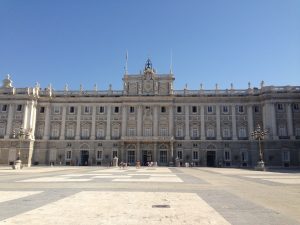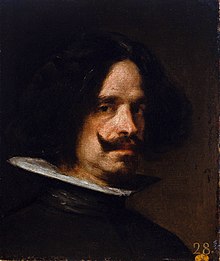Madrid’s Palacio Real – the ceremonial royal palace of Spain, located in western downtown Madrid. It was built from 1738-1755. The Spanish royal family actually lives in the Palace of Zarzuela on Madrid’s outskirts.

A ninth-century Moorish castle – an Alcázar (fortress) built under the reign of Muhammad I, ruler of Cordóba, as an outpost.
Plaza de la Armería – the square formed by the Palacio Real and the Almudena Cathedral. Despite coming into existence in 1553 with the construction of a royal stable, the square did not assume its present configuration until 1892, under the designs of architect Enrique María Repullés.

Diego Velázquez (1559-1660) – an important painter of the Spanish Golden Age who featured prominently in King Philip IV’s court. His painting Caballo blanco, shown below at right opposite his self-portrait, is on display in the Royal Palace.


Francisco Goya (1746-1828) – often viewed as the paramount Spanish artist of the late 1700s and early 1800s, he was a painter and printmaker of the Romantic period. Four of his paintings, largely focused on King Charles IV and his family, are on display at the Royal Palace.

Peter Paul Rubens (1577-1640) – a Flemish Baroque artist whose works include historical paintings, portraits, landscapes, tapestries, and prints. It is unclear which Rubens works Brown references as being on display at the Royal Palace.

Palacio de la Zarzuela – located on the outskirts of Madrid, this is the residence of the Spanish royal family. It was constructed in the 1600s under King Philip IV.

Spain’s rich Catholic history – Spain has been a predominantly Catholic nation since the late 1400s; most modern-day Spaniards are Catholic, although many do not attend mass regularly.
Current Spanish royal family – Dan Brown’s fictional Spanish royal family bears some resemblance to the actual royal family. The current king is Felipe VI (whose Origin counterpart is Crown Prince Julián), who assumed the throne on June 19, 2014, after his father, King Juan Carlos I (whose Origin counterpart lacks a name), abdicated. (Juan Carlos is still alive, as is his wife, Queen Sofía, unlike the former king and queen in Origin.) The current queen of Spain, Felipe’s wife, is former television reporter Letizia Ortiz, the first-ever Spanish commoner to reach the queen’s throne. The character of Ambra Vidal likely takes inspiration from Queen Letizia, as Ambra also comes from a commoner family and is a prominent figure in society outside of her relationship with royalty. The king and queen have two daughters, 11-year-old Leonor, Princess of Asturias (signifying that she is first in line for the throne), and 10-year-old Infanta (“Princess”) Sofía.

“Guardarropía Real” – Ambra constructed this pun by combining the Spanish words for “royal guard” (Guardia Real) and “wardrobe” (guardarropa).
Don – an honorific male title used in Spain, among other places, to designate royalty and other highly esteemed individuals.
su alteza – Spanish translation of “his highness” or “her highness,” used as a royal title.
Editor: Maja Cannavo
You must be logged in to post a comment.